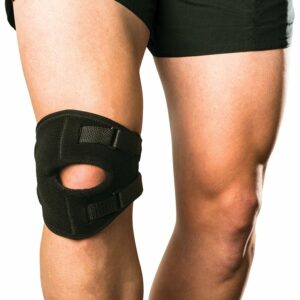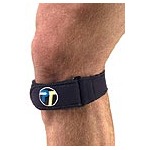Patella Taping
Updated:
The following patella taping technique is designed to support the patella, correct abnormal patella alignment (lateral tracking) and reduce stress on the knee during activity. It can be used for both the treatment and prevention of knee injuries, particularly those associated with abnormal patella tracking such as patellofemoral pain syndrome (runner’s knee), patella instability and patella dislocation. It may also assist with improving the activation of the VMO muscle (inner quadriceps – Figure 1), which can aid rehabilitation of many knee injuries.
You should discuss the suitability of this taping technique with your physiotherapist prior to using it. Generally, it should only be applied provided it is comfortable and does not cause an increase in pain, discolouration, pins and needles, numbness, swelling, itchiness or excessive redness of the knee, foot or ankle.
What sort of tape should be used to tape my patella?
There are many different tapes and bandages available for use by physiotherapists and patients. However, when the purpose is to restrict undesired motion and to support and improve positioning of the patella, only adhesive, non-stretch (rigid) sports tape is appropriate. (For patella taping 38mm is usually the most appropriate size). This should always be used in combination with hypoallergenic tape as an underlay, such as Fixomull.
Benefits of Patella Taping
When used correctly, patella taping techniques can:
- Decrease pain during sport or activity
- Aid healing of certain knee injuries
- Correct patella alignment
- Allow an earlier return to sport or activity following injury
- Reduce the likelihood of injury aggravation
- Prevent knee injuries (such as a dislocated patella) during high risk sports (such as netball, basketball, football, soccer etc.)
- Improve activation of the VMO muscle (Inner Quadriceps – figure 1)
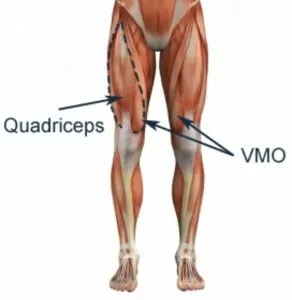
Indications for Patella Taping
It is generally beneficial to tape the patella in the following instances:
- With certain knee injuries – such as patellofemoral pain syndrome where abnormal patella tracking is contributing to the injury (this should be discussed with the treating physiotherapist as certain knee injuries should not be taped – such as some fractures).
- To prevent injury or injury aggravation – Patella taping may be beneficial during sports or activities that place the knee (patellofemoral joint) at risk of injury or injury aggravation (such as netball, basketball, football, soccer etc.)
When should I avoid Patella Taping?
Patella taping should be avoided in the following instances:
- If you have certain injuries such as some fractures (this should be discussed with the treating physiotherapist)
- If you have a skin allergy to sports tape
- If the taping technique results in an increase in symptoms such as pain, ache, itchiness, discolouration, pins and needles, numbness, swelling, or excessive redness of the knee, foot or ankle.
- If you have sensory or circulatory problems
Weaning off patella tape in general activity is usually recommended as strength, range of movement, patella positioning, biomechanics and balance improve and symptoms reduce. In these instances though, taping during high-risk activity (such as sport) is usually still recommended.
Patella Taping Technique
The following patella taping technique may be used to provide support for the patella and knee and to reduce abnormal patella positioning or tracking (lateral patella tracking). Generally it is recommended that the knee is shaved 12 hours prior to taping (to prevent painful removal of hairs and skin irritation). The skin should be cleaned and dried, removing any grease or sweat. Low irritant Fixomull tape should be applied as an under-wrap to reduce the likelihood of skin irritation with rigid sports tape over the top of this.
McConnell Medial PatellaTaping
Begin lying on your back, with the knee slightly bent, but completely relaxed and a foam roller or rolled up towel under the knee. Start the tape in line with the middle of the knee cap at the outer aspect of the knee. Using your thumb on top of the sports tape, gently push the knee cap towards the inner aspect of the knee (figure 2) whilst simultaneously using your fingers to pull the skin at the inner aspect of the knee towards the knee cap. Finish this taping technique at the inner aspect of the knee ensuring you have created some wrinkling of the skin at the inner aspect of the knee (figure 3). Repeat this process 1 – 3 times depending on the amount of support required.
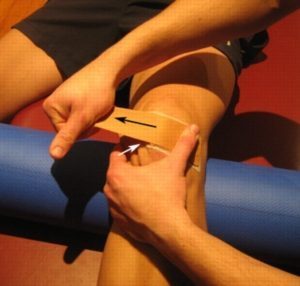
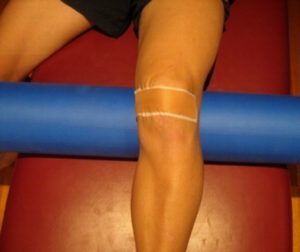
Removing the tape
Care should be taken when removing the tape to avoid injury aggravation or skin damage. The tape should be removed slowly, pulling the tape back on itself with pressure placed on the skin as close as possible to the line of attachment of the tape.Generally tape should be removed within 48 hours of application or sooner if there is any increase in pain or symptoms (including skin irritation or itchiness).
Patella Taping Summary

Members Only ContentBecome a PhysioAdvisor Member to gain full access to this exclusive content. For more details see Become a Member. Already a member? Login Now
 Physiotherapy Products for Patella Taping
Physiotherapy Products for Patella Taping
To purchase physiotherapy products to assist with Patella Taping click on one of the above links or visit the PhysioAdvisor Shop.
 Knee Exercises
Knee Exercises
- View Knee Stretches.
- View Knee Strengthening Exercises.
- View Balance Exercises.
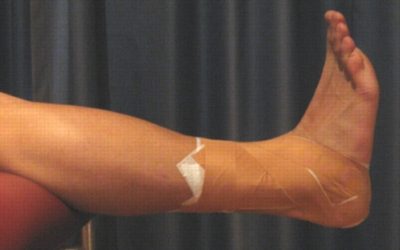 Other Taping Techniques
Other Taping Techniques
- Ankle
- Back
- Elbow
- Fat Pad (Infrapatellar)
- Finger
- Foot
- Knee
- Patella Tendon
- Posture
- Shoulder
- Tennis Elbow
- Thumb
- Wrist
 Find a Physio
Find a Physio
Find a physiotherapist in your local area who can help with Patella Taping.
 More Information
More Information
- Read about Patella Dislocation.
- Read about Patellofemoral Pain Syndrome (Runner’s Knee).
Become a PhysioAdvisor Member
-
 Individual Membership (12 Months)$59.95 for 1 year
Individual Membership (12 Months)$59.95 for 1 year -
 Individual Membership (3 Months)$39.95 for 3 months
Individual Membership (3 Months)$39.95 for 3 months -
 Individual Membership (Yearly)$49.95 / year
Individual Membership (Yearly)$49.95 / year -
 Individual Membership (Monthly)$15.95 / month
Individual Membership (Monthly)$15.95 / month

Link to this Page
If you would like to link to this article on your website, simply copy the code below and add it to your page:
<a href="https://physioadvisor.com.au/health/taping-techniques-lower-body/patella”>Patella Taping – PhysioAdvisor.com</a><br/>PhysioAdvisor offers expert physiotherapy advice on McConnell Patella Taping techniques for excellent knee support.
Return to the top of Patella Taping.

